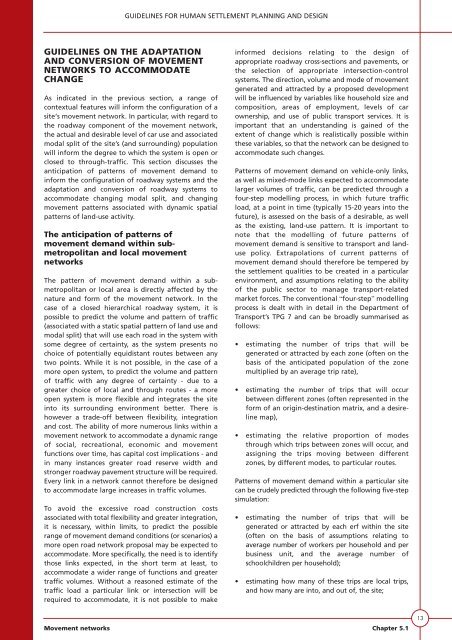VOLUME 1 HUMAN SETTLEMENT PLANNING AND ... - CSIR
VOLUME 1 HUMAN SETTLEMENT PLANNING AND ... - CSIR
VOLUME 1 HUMAN SETTLEMENT PLANNING AND ... - CSIR
- No tags were found...
Create successful ePaper yourself
Turn your PDF publications into a flip-book with our unique Google optimized e-Paper software.
GUIDELINES FOR <strong>HUMAN</strong> <strong>SETTLEMENT</strong> <strong>PLANNING</strong> <strong>AND</strong> DESIGNGUIDELINES ON THE ADAPTATION<strong>AND</strong> CONVERSION OF MOVEMENTNETWORKS TO ACCOMMODATECHANGEAs indicated in the previous section, a range ofcontextual features will inform the configuration of asite‘s movement network. In particular, with regard tothe roadway component of the movement network,the actual and desirable level of car use and associatedmodal split of the site’s (and surrounding) populationwill inform the degree to which the system is open orclosed to through-traffic. This section discusses theanticipation of patterns of movement demand toinform the configuration of roadway systems and theadaptation and conversion of roadway systems toaccommodate changing modal split, and changingmovement patterns associated with dynamic spatialpatterns of land-use activity.The anticipation of patterns ofmovement demand within submetropolitanand local movementnetworksThe pattern of movement demand within a submetropolitanor local area is directly affected by thenature and form of the movement network. In thecase of a closed hierarchical roadway system, it ispossible to predict the volume and pattern of traffic(associated with a static spatial pattern of land use andmodal split) that will use each road in the system withsome degree of certainty, as the system presents nochoice of potentially equidistant routes between anytwo points. While it is not possible, in the case of amore open system, to predict the volume and patternof traffic with any degree of certainty - due to agreater choice of local and through routes - a moreopen system is more flexible and integrates the siteinto its surrounding environment better. There ishowever a trade-off between flexibility, integrationand cost. The ability of more numerous links within amovement network to accommodate a dynamic rangeof social, recreational, economic and movementfunctions over time, has capital cost implications - andin many instances greater road reserve width andstronger roadway pavement structure will be required.Every link in a network cannot therefore be designedto accommodate large increases in traffic volumes.To avoid the excessive road construction costsassociated with total flexibility and greater integration,it is necessary, within limits, to predict the possiblerange of movement demand conditions (or scenarios) amore open road network proposal may be expected toaccommodate. More specifically, the need is to identifythose links expected, in the short term at least, toaccommodate a wider range of functions and greatertraffic volumes. Without a reasoned estimate of thetraffic load a particular link or intersection will berequired to accommodate, it is not possible to makeinformed decisions relating to the design ofappropriate roadway cross-sections and pavements, orthe selection of appropriate intersection-controlsystems. The direction, volume and mode of movementgenerated and attracted by a proposed developmentwill be influenced by variables like household size andcomposition, areas of employment, levels of carownership, and use of public transport services. It isimportant that an understanding is gained of theextent of change which is realistically possible withinthese variables, so that the network can be designed toaccommodate such changes.Patterns of movement demand on vehicle-only links,as well as mixed-mode links expected to accommodatelarger volumes of traffic, can be predicted through afour-step modelling process, in which future trafficload, at a point in time (typically 15-20 years into thefuture), is assessed on the basis of a desirable, as wellas the existing, land-use pattern. It is important tonote that the modelling of future patterns ofmovement demand is sensitive to transport and landusepolicy. Extrapolations of current patterns ofmovement demand should therefore be tempered bythe settlement qualities to be created in a particularenvironment, and assumptions relating to the abilityof the public sector to manage transport-relatedmarket forces. The conventional “four-step” modellingprocess is dealt with in detail in the Department ofTransport’s TPG 7 and can be broadly summarised asfollows:• estimating the number of trips that will begenerated or attracted by each zone (often on thebasis of the anticipated population of the zonemultiplied by an average trip rate),• estimating the number of trips that will occurbetween different zones (often represented in theform of an origin-destination matrix, and a desirelinemap),• estimating the relative proportion of modesthrough which trips between zones will occur, andassigning the trips moving between differentzones, by different modes, to particular routes.Patterns of movement demand within a particular sitecan be crudely predicted through the following five-stepsimulation:• estimating the number of trips that will begenerated or attracted by each erf within the site(often on the basis of assumptions relating toaverage number of workers per household and perbusiness unit, and the average number ofschoolchildren per household);• estimating how many of these trips are local trips,and how many are into, and out of, the site;Movement networks Chapter 5.113
















